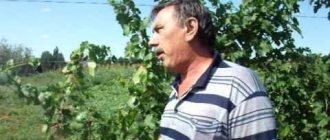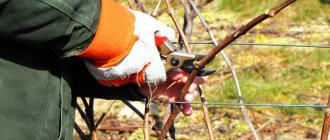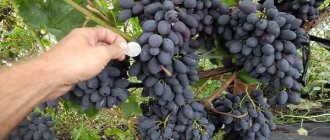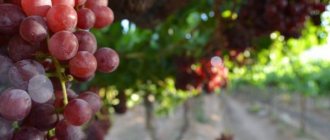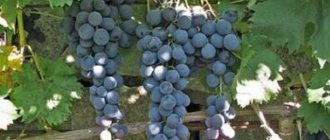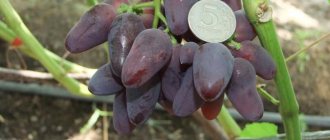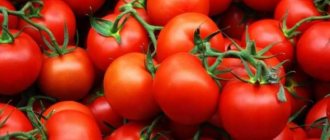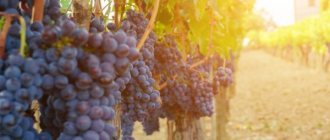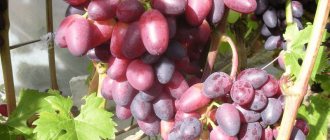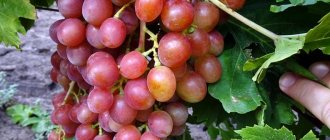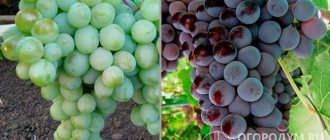Denisovsky makes excellent juice
The variety is intended for the production of dry, dessert and sparkling wines. It is also used in the preparation of compotes, jams and preserves.
History of appearance
The Denisovsky grape appeared by pollinating the Northern Muscat.
Initially, breeders planned to obtain a technical variety that would tolerate cold well. After painstaking work, the breeders of VNIIViV named after. Potapenko managed to obtain a new hybrid - Denisovsky grapes, which met the objectives, namely, to obtain a high-yielding variety that could perfectly withstand frost and not succumb to fungal diseases. As a result, it was possible to develop early grapes that do not require shelter. It was bred by breeders from VNIIViV named after. Potapenko - from pollination by pollen of the Severny muscat variety.
The specialists were faced with the task of developing a variety that would feel good in latitudes with a real Russian winter and would not be primitive. Therefore, Denisovsky became widespread throughout the Caucasus.
Description of the benefits of the variety
| Purpose of the variety | wine |
| Acidity of the variety | 7 - 8 g/l |
| Sugar content of the variety | 20 — 22 % |
| Bunch shape | cylindrical-conical |
| Bunch weight | 210 g |
| Berries shape | oval |
| Berry color | deep black with white tint |
| Berry size | 2 g |
| Taste | rich nutmeg and harmonious |
- Absolutely low maintenance.
- Increased frost resistance.
- Berries store sugar well.
- Denisovsky’s taste cannot be called refined, but it is not primitive and is completely devoid of sharpness, like, for example, the famous Isabella with the smell of “fox”.
- Excellent transportability.
- And you don’t even need to choose the soil in particular - well, unless it’s too swampy, and a salt marsh won’t do, but Denisovsky is unpretentious in everything.
The Denisovsky wine grape variety was obtained by crossing Severny with a mixture of muscat pollen in Russia on the territory of the vineyards of the All-Russian Scientific Research Institute named after Ya.I. Potapenko. The variety is a purely technical subspecies, therefore it is used mainly in winemaking in the North Caucasus.
- Absolutely low maintenance.
- Increased frost resistance.
- Berries store sugar well.
- Denisovsky’s taste cannot be called refined, but it is not primitive and is completely devoid of sharpness, like, for example, the famous Isabella with the smell of “fox”.
- Excellent transportability.
- And you don’t even need to choose the soil in particular - well, unless it’s too swampy, and a salt marsh won’t do, but Denisovsky is unpretentious in everything.
The Denisovsky wine grape variety was obtained by crossing Severny with a mixture of muscat pollen in Russia on the territory of the vineyards of the All-Russian Scientific Research Institute named after Ya.I. Potapenko. The variety is a purely technical subspecies, therefore it is used mainly in winemaking in the North Caucasus.
Description of diseases and pests
Resistance to diseases and pests, as already mentioned, is quite high: Denisovsky’s increased resistance to mildew and gray rot - 3 points each, as well as the average score for resistance to oidium - 4 points allows us to talk about its attractiveness for beginners in viticulture. The leaf roller will also avoid it.
In general, if you cannot grow such an unpretentious variety as Denisovsky, then you should think about changing your activity. The Denisovsky variety can still be grown by any novice winemaker. A little effort and homemade wine with the aroma of the Caucasus will give your home feast a unique atmosphere of celebration and fun.
Denisovo grapes, described above, are practically not susceptible to diseases that affect other varieties. On a five-point scale, the plant has the following indicators:
- resistance to mildew and other types of rot – 3 points;
- resistance to oidium – 4 points.
This plant is not attacked by the leaf roller. Gardeners leave mostly positive reviews about this variety. Denisovsky grapes do not require complex care. Sometimes you can see wasps on it. To prevent insects from avoiding ripe clusters, gardeners recommend covering the berries with a fine net.
Harvesting and storage
The fruits ripen in mid or late August. This variety is usually used for the production of dry or dessert wines. It is also used to make sparkling champagne. The Denisovsky variety can be used for various preparations. Compotes, jams, and liqueurs are made from it.
The Denisovsky variety is considered a popular industrial crop, which is actively used for wine production. To achieve success in growing a plant, it is worth providing it with complete and high-quality care.
Sources:
https://selo.guru/sadovodstvo/vinograd/denisovskij.html https://dachadacha.com/rasteniya/plodovyj-sad/vinograd-plodovyj/denisovskij https://xn—-7sbabudf4czbg.xn--p1ai/opisanie- vinograda-sorta-denisovskij-pravila/
Landing Features
The Denisovsky grape variety does not belong to dessert types. They are wine grapes prized for the high-quality wine produced from their juice. The berries have a very harmonious taste without any zest.
History of appearance
Denisovsky grapes differ from other varieties in the strong growth of the bush. It has small clusters, weighing about 200 grams, and cone-shaped. Sometimes brushes with wings are found.
The berries of the variety are small, weighing about three grams. Their shape is round. The skin color is dark blue with a pronounced coating. It is quite dense and strong, which allows you to transport the crop over long distances without losing the quality of the bunch. The pulp has a simple grape sweet taste.
The Denisovsky grape has medium-sized leaves that are slightly dissected and slightly pubescent below.
The new selection has a number of advantages over other varieties, which are presented in the table below.
Read more: When hazelnuts are harvested, the time of fruit ripening
| Purpose | Wine |
| Acidity | 7-8 g/l |
| Sugar content, % | 20-22 |
| Brush shape | Cylindrical |
| Brush weight | On average 200 grams |
| Taste | Rich, sweet, harmonious |
| Feature of colors | Bisexual, do not require additional pollination |
| Ripening period | From bud break to harvest 120 days (end of August) |
| Frost resistance | Up to -27 degrees does not require shelter |
Features of the variety
Denisovsky grapes are unpretentious in care. Its berries accumulate sugar well, which is important when using them in winemaking.
The variety has a very interesting taste. It cannot be called sophisticated, but it is not considered primitive either. The berries are sweet, without sourness, with a pronounced classic grape taste.
The plant thrives in almost any soil, except very swampy soil. Also, grapes do not grow on salt marsh, but on other types of soil the plant gives a stable high yield.
During the development period, the plant develops powerful deep roots. The bush itself is vigorous, so when pruning, about 35 eyes are left on it, and the remaining branches are removed.
Landing Features
This variety is considered one of the most unpretentious. As mentioned above, it can be grown in any type of soil. When choosing a planting site, preference should be given to options with low salt content. Denisovo grapes also do not like high humidity.
This variety belongs to light-loving plants. To plant it, choose an area with good lighting, without shading. When planting cuttings, already in the first year of growing season the plant grows powerful shoots.
The bush is distinguished by its vigorous growth. Therefore, when planting, you should leave enough space for it to develop normally. Gardeners say that the distance between bushes should not be less than one and a half meters. A distance of three meters is maintained between rows.
Denisovsky grapes are ideal for propagation by vegetative method. Other varieties can be grafted onto cuttings.
There are no special features in caring for grapes. The plant must be watered, promptly sprayed against pests, and also periodically fertilized with mineral and organic fertilizers.
Typically, nitrogenous, phosphorus-potassium fertilizers are used for grapes. Complex mineral fertilizers containing vitamins are used less frequently.
Purpose of the variety
Denisovsky was bred as a wine variety. However, its taste makes it possible to use the berries for making jams, preserves and compotes. Dry and sparkling wines of high quality are obtained from grapes. The berries are used to make liqueurs.
Properly selected planting site and timely watering will allow you to get a good harvest. The variety is capable of producing up to 140 centners of tasty berries per hectare of land.
Gardeners say that even a novice winemaker can grow Denisovsky grapes. You just need to put in a little effort.
Denisovsky is not too demanding in care. Like all grape plants, it needs good sunlight. It is unpretentious to soils, but planting it on soil with a high salt content (saline soils) should be avoided. Swampy areas and soils with high humidity are also undesirable.
Due to their good growth, it is recommended to plant the bushes 1.5 meters apart with a distance between rows of 3 meters. To maintain a stable high yield, it is necessary to prune the vine into 6-8 buds. The optimal load on the bush is from 30 to 40 eyes. The hybrid has good compatibility with vigorous rootstocks, for example, Kober 5BB.
Due to its good sugar content, these grapes are used to make high-quality dessert, as well as sparkling and dry wine. Despite the rather simple taste, the dry wine produced from this hybrid has a good tasting score - 7.8 points. In addition, it makes excellent compotes, preserves and jam, and thanks to the beautiful attractive bunches, many gardeners decorate their facades and hedges with it.
Subtleties of growing varieties
In order for a culture to develop normally, it is recommended to provide it with optimal conditions. To do this, it is important to carry out planting work correctly.
Landing dates
It is worth planting crops in harsh climates in the spring. In the southern regions it is permissible to do this in the fall.
Site preparation
The variety is considered light-loving. Therefore, a well-lit area is suitable for planting it.
Related article: The wine industry is interested in planting “clean plants”
It is not recommended to plant grapes in the shade.
Planting process
The plant is unpretentious to the composition of the soil. However, it is not recommended to plant it in soil with a high salt content. It is also undesirable to choose swampy places and soil with high humidity.
The bushes develop quickly and are characterized by strong growth. Therefore, they should be planted at intervals of 1.5 meters. The distance between rows is 3 meters.
What type does it belong to?
Denisovsky is a technical subspecies with an early ripening period. It is used primarily in a blend of dry red, sparkling and sweet wines.
Technical varieties also include Levokumsky, Bianka and Augusta.
Included in the State Register (North Caucasus region). Well stored and transported. Also popular in making jams, preserves, compotes, and liqueurs.
The clusters are very beautiful, blue. That’s why farmers love to decorate facades and hedges with these grapes. Tolerates storage and transportation well.
Among the beautiful varieties, Romeo, Chocolate and Taifi stand out.
"Denisovsky" - technical grape variety
Features of the variety
Denisovsky is a technical grape variety and belongs to the early ripening variety. It is mainly used for blending dry red, sparkling and sweet wine. Listed in the State Register of the Russian Federation (for the North Caucasus region). It is well preserved and tolerates transportation well. In addition, it is widely used for preparing products such as preserves, jams, liqueurs, compotes.
It is distinguished by extremely beautiful clusters and attractive blue berries, which is why many farmers decorate their facades with plants of this variety. Can last for a very long time.
Characterized by high growth vigor. The bunches are small, the average weight of a bunch is 200 g, the shape of the bunch is cylindrical and cone-shaped, in some cases there are “wings”. The berries are small in size (most berries weigh 2 or 3 g), round in shape, dark blue in color and have a light white coating. The skin of the berries is very dense. They have extremely sweet-tasting flesh. The leaves are of medium size, weakly dissected, with slight pubescence at the bottom. Flowers are hermaphrodites. The shoots are distinguished by a reddish color and dark red nodes. The vines are brown in color and quite powerful.
The Denisovsky variety is highly resistant to grape diseases and pests, especially gray rot, as well as mildew. Its resistance to oidium and leaf roller is somewhat lower.
Advantages and disadvantages
Advantages of the Denisovsky grape variety:
- Unpretentiousness in terms of care.
- Fruits have a high ability to accumulate sugar.
- The taste is quite mild, not sharp, unlike, for example, the popular Isabella variety.
- High transportability.
- Complete unpretentiousness to the soil - only very swampy soils and salt marshes are not suitable at all.
High frost resistance.
No significant deficiencies were found in this variety.
Features of care
The Denisovsky variety is unpretentious in terms of cultivation due to its high resistance to frost and can withstand temperatures down to -27; sugar quickly accumulates in its berries; it can easily be transported; the taste of the berries is not at all sharp; special conditions for cultivation are not required.
When planting this grape variety, it is necessary to take into account its sensitivity to salt marshes and marshy soil, therefore it should not be placed in such conditions. In all other respects, it does not create significant trouble. In the case of a single planting, a hole is dug, the depth of which is 0.6 m and which has the same dimensions of the edges. When planting two or more vines, a trench is immediately dug, the depth of which is 0.6 m, followed by the installation of trellises. The location should be well lit by the sun.
The Denisovsky variety, like any other, requires protection from common pests, including the following measures:
- covering the vines with netting to protect them from birds;
- prevention against bacterial cancer - uprooting and removing diseased parts and protecting the vines from damage.
Description of shoots
The shoots of this variety bear fruit on average - approximately 65-76 percent; if we talk about clusters, their number per shoot is about 1.2. When pruning the fruit vine, it is recommended not to load too much - a length of 6-7 eyes will be enough. Denisovsky is distinguished by an average level yield (approximately 140 c/ha) - that is, if planting is carried out according to the scheme of 3 bushes per one and a half meters of land, then the yield will be 4 kilograms per bush.
The shoots of this variety bear fruit on average - approximately 65-76 percent; if we talk about clusters, their number per shoot is about 1.2. When pruning the fruit vine, it is recommended not to load it too much - a length of 6-7 eyes will be enough. Denisovsky is distinguished by an average yield level (approximately 140 c/ha) - that is, if planting is carried out according to the scheme of 3 bushes per one and a half meters of land, then the yield will be 4 kilograms per bush.
Appearance of the vine and fruits
Grapes are not intended for table decoration; the description classifies them as crops that are processed and not sold.
Vine and shoots
Description of the vine: brown grape bushes are vigorous, with a powerful developed root system. Resistant to fungal attack. When pruning, approximately 35 eyes are left per bush. The leaf blade is slightly pubescent along the lower edge and dissected.
Reddish shoots have average fruitfulness, about 65–75%. During the autumn pruning period, the vines are left 6-7 buds long.
When planting 3 bushes per 1.5 m2 of soil, grapes will have an average yield of approximately 4 kg of berries per bush.
Bush in the third year after planting
Berries and bunches
Description of the Denisovsky variety bunch: has a cylindrical-conical shape of medium volume with a weight of approximately 210 g. The presence of “wings” on the bunch is acceptable. The medium-sized berry weighs 2–3 grams and has a deep blue color with a white coating. The taste of the berry pulp is sweet with a bright nutmeg shade. The sugar content of grapes is 20–22% with an acidity of 8 g/l.
Read more:
- Grapes Maxi description of variety, planting, care
- Extravaganza pear description of the variety, care features
- Skorospelka pear from Michurinsk variety description, care features
- Pear variety Simply Maria: description and cultivation of the plant
Forum statistics
207036 Messages in 1634 Topics from 5593 Users. Last user: Amaya Last message: “Let's talk about the weather in Vash...” ( Today at 07:52:22 ) Latest messages on the forum.
Now on the forum
42 Guests, 14 Users
Users in the last 15 minutes: marlin64, Nikolay 2, rambo, Vasily 53, ALEX, Elvira2017, 77volt, Evgeniy52, kvg, ElenkaF, sergei, Ser, Evgeniy 163, Lyubov S. [Blocked] [Section Moderator] [Forum Moderator]
Maximum online today: 100 . All-time maximum online: 2758 (28 July 2021, 17:22:51)
Users who visited the forum in the last 24 hours
Total: 295
(Visible: 294, Hidden: 1) 1963, marlin64, Nikolay 2, Vasily 53, rambo, ALEX, 77volt, Elvira2017, kvg, Evgeniy52, ElenkaF, sergei, Ser, Evgeniy 163, Lyubov S., Erem, Ekaterina Polyanina, kosmos , Yura, GALINA ANOKHINA, DorontsovPeter, ZaycevAS, Alex65, 64nikolay64, Vova Kapran, zsb, Polina77, spotlight, Mikhail Alekseevich, Svetla777, Quiet, Marshal, Nikolay S., therapist, Liza, Capricorn, lomakin1969, Alexander Vl., Andrey76, Slavka, Mikhail77, Tatyana B, Cherkessk, Eugene, leonidych, vladimirM, yotmast, mers, Serg1707, SNovichek, hanter64, znakomij, Alexander K, Vardan, Sergey Fer, Anatoly Sivkov, Alexey V, Ilya 77, Andrey Gladilin, Tatyana A. , Belgorodets, in Astrakhan, Oksana Kopp, sem_en, Vladimir 153, skier, Igor Viktorovich, slavalimon, Primorets, OlgaOs, SANYCH, 31rus, mystic69, Andrey Tsvetkov, Buba, igor222, Elena Z, vlad51, Kenig, Nikolay Rex, Sergey 1965 , Vladimir Buturlakin, DSW, psv1960, Dmitry 77, Vasily V., Vyacheslav03, Natalia Nikolaevna, Sergey Tashchiyan, Igor Sergeevich, alexsandr, Pioneer, nicson7, Elena Aleshchenko, Alexander-ask-34, Verona, Igor F., Taker, Henry , Yuri72, L.A.P., Yuri Gaivoronsky, Sergeevich, Sergei Chistokletov, Svetlana Streletskaya, Galinka, Alexey Deminov, Igor Naumov, Vyacheslav136, Gloomy, Katrin, AndSanych, Alexander Mikhno, Ded31, Oleg Filippov, Vladimir ++, Lydia58 , ALEXANDER BRYANSKY, Vladimir-kanevskaya, DIL, Amber7394, Marina Protasova, TITOVA LYUBOV, Linx, alexander66, Natalya M, Mikhail Fesenko, Amaya, Alexander71, Boris 1952, tsv, Maximilian, 25nata35, nadia, Igor_K, Alexander Kolesnikov, Ivan Levin , Pitko, weather forecaster, eSAa, cecet71, atseton, Alexander Smirnov, Vladimir Kostochkin, Vladimir Berdnikov, Gocha, pioneer-2, LeXa_KoT, Sergey 61, Sergey Yuryev, alexss, Skif, Vladimir Kovba, dayton, Yuri Semyonov, N.A. Sokolov, Pavlentiy, Sa-shura, Volgogradka, Dmitry Anatolyevich, Grandfather Igor, Andrey Lis, Bublichenko Alexander M, Marina Krymskaya, stenlly2010, irahelm, Vyacheslav Vladimirovich, Vladimir Shilov, Aprel, Badaev Dmitry, gheo55, y_fed, Yagodka, Valentina Ivanovna, Kryn, oleg9f, DED2, Svetlana Korotina, Oleg Ivanovich delivered, Eduard., santra, L2k2m7n, Alexander48, Viknik, Andrey 31, m2d, Valery Rastorguev, Soshnin Yura, Amateur gardener, Galina, Vasily1111, gardener, Salex, Sergey Ko, Ramiz, Victor_, potap05, Yuri 36, VitalySD, Inna161, Vladimir Shcherbinin, Valerie, niy1, cfibr, Andrey68, kulol3, thanatos, Serzh1978, Realist, Artur53, max2008-01, LOZA, AlexanderD, Ded Young, Natasha, Zayac, ketch , Rita, alx-74, Iv Iv, Alexander150, Igor K, Vasily Viktorovich, VeraNiK, kdm57, Veniaminovich, Boris Sokolyansky, , vikbublik, neposny, Evgen, Victoria Aleksandrovna, Serezha 64, Wintel, Airbone, teri, Sergey Lomonosov, Khramov , serzhinio, Leonty Yarygin, Irina O., Nadezhda Grig, netolya, Saisan, Alexey Agryzkov, Vadi, Zinaida, Vadim, Alexander Taganrog, Sergey Sukhonos, Snezhinets, evgen_26, nau_63, Masha_sadovod, Gennady163, krasnovlad1, Alexander Zinoviev, Roman Fedorovich, TIS, Alexey Sergeevich, arnyusha, Zheka, Nurtas, kradievska, nick041, Valentina Medvedeva, Sergey43, Andrey S., Nikolay Lipunov, Mst, Vertuoz2, Vladimir VS, NatalyaMed, freesia, Kinna, Mikhail Michurinsk, alekcsan1, VALERY TAMB, Sasha57, MikhAf, Y_Azer, Andrey Beribesov, hunter1955, nut lover, Keys, Ivan Shmelev, Pestle, anton_slash, Nadymchanka, Sergey 31, Volgar, Pavel 64, Tatyana Volzh, Elektronik_t
